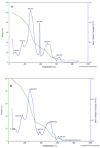Utilizing Xanthan Gum Coatings as Probiotic Bacteria Carriers to Enhance Postharvest Quality and Antioxidants in Fresh-Cut Cantaloupe and Honeydew (Cucumis melo L.) Melons
- PMID: 38540930
- PMCID: PMC10970161
- DOI: 10.3390/foods13060940
Utilizing Xanthan Gum Coatings as Probiotic Bacteria Carriers to Enhance Postharvest Quality and Antioxidants in Fresh-Cut Cantaloupe and Honeydew (Cucumis melo L.) Melons
Abstract
Due to spoilage microflora and browning, minimally processed fresh-cut fruits have a short shelf life, and over the years, studies have shown the potential of using edible coatings to extend the shelf life and improve the safety of fresh-cut fruits. Recently, there has been a rise in research on the incorporation of probiotics in edible coatings due to the bespoke health and biopreservation benefits they impart. Therefore, in this study, lactobacillus strains (Lactiplantibacillus plantarum 75 and Bifidobacterium longum) were incorporated into a xanthan edible coating to enhance color retention, sensory properties, antioxidant retention (ascorbic acid, carotenoids, total phenols), and antioxidant activity (FRAP antioxidant power, ABTS scavenger activity) of fresh-cut cantaloupes and honeydew cucumis melo L. melons during cold storage at 5 C and 85% RH for five days. The edible coating was prepared by mixing 0.5% xanthan gum, 1% glycerol, and 2% citric acid solution with L. plantarum 75 (LAB 75) and Bifidobacterium longum bacteria separately, and the final lab count for each strain was made to be 8.0 log CFU/mL. Stable probiotic coatings with ζ-potential of between -39.7 and -51.4 mV and a PdI of 1 were developed, and the incorporation of the probiotic bacteria into the coating was justified using FTIR analysis. The probiotic coatings showed a typical pseudoplastic behavior, in which the viscosity curves fall as the shear rate increases. Thermal stability analysis showed a continuous and multi-step weight reduction in this work, illustrating how the edible coating components interact. The survival of both Lactobacillus strains was recorded on day 5. Both freshly cut melons coated with xanthan and loaded with Lactobacillus strains retained a sufficient quantity of probiotics at the end of storage, while L. plantarum 75 (7 log CFU/g for cantaloupe and 8 log CFU/g for honeydew) retained the highest viability compared to B. longum (6 log CFU/g for cantaloupe and 7 log CFU/g for honeydew). In comparison to the coated and uncoated control samples, the inclusion of L. plantarum 75 in xanthan coatings significantly retained the color properties, pigments (total chlorophyll and carotenoids), ascorbic acid, total phenols, and antioxidant activity (FRAP, DPPH, and ABTS). The overall acceptability of fresh cuts of cantaloupe and honeydew melons coated with xanthan gum loaded with L. plantarum 75 was higher than that of other treatments. Thus, xanthan gum loaded with L. plantarum 75 coating is most suitable for reducing postharvest losses in fresh cuts of honeydew melons and cantaloupe, which will help preserve antioxidant and bioactive properties. The xanthan gum loaded with L. plantarum 75 coatings exhibited the highest preservation impact; therefore, it can be recommended for the fresh-cut industry.
Keywords: antioxidant properties; bioactive compounds; color properties; edible coating; lactobacillus strains; sensory properties.
Conflict of interest statement
The authors declare no conflicts of interest.
Figures











Similar articles
-
Bioactive edible film based on Konjac glucomannan and probiotic Lactobacillus plantarum strains: Physicochemical properties and shelf life of fresh-cut kiwis.J Food Sci. 2021 Feb;86(2):513-522. doi: 10.1111/1750-3841.15568. Epub 2021 Jan 7. J Food Sci. 2021. PMID: 33415755
-
Viability of Lactobacillus plantarum on Fresh-Cut Chitosan and Alginate-Coated Apple and Melon Pieces.Front Microbiol. 2018 Oct 23;9:2538. doi: 10.3389/fmicb.2018.02538. eCollection 2018. Front Microbiol. 2018. PMID: 30405587 Free PMC article.
-
Effect of time before storage and storage temperature on survival of Salmonella inoculated on fresh-cut melons.Food Microbiol. 2007 May;24(3):288-95. doi: 10.1016/j.fm.2006.04.007. Epub 2006 May 9. Food Microbiol. 2007. PMID: 17188207
-
Current Advances on the Development and Application of Probiotic-Loaded Edible Films and Coatings for the Bioprotection of Fresh and Minimally Processed Fruit and Vegetables.Foods. 2021 Sep 17;10(9):2207. doi: 10.3390/foods10092207. Foods. 2021. PMID: 34574315 Free PMC article. Review.
-
Emerging Trends and Application of Edible Coating as a Sustainable Solution for Postharvest Management in Stone Fruits: A Comprehensive Review.Compr Rev Food Sci Food Saf. 2025 May;24(3):e70179. doi: 10.1111/1541-4337.70179. Compr Rev Food Sci Food Saf. 2025. PMID: 40370183 Free PMC article. Review.
Cited by
-
Edible Alginate-Fungal Chitosan Coatings as Carriers for Lacticaseibacillus casei LC03 and Their Impact on Quality Parameters of Strawberries During Cold Storage.Foods. 2025 Jan 10;14(2):203. doi: 10.3390/foods14020203. Foods. 2025. PMID: 39856871 Free PMC article.
References
-
- Opara U.L., Al-Ani M.R. Antioxidant contents of pre-packed fresh-cut versus whole fruit and vegetables. Br. Food J. 2010;112:797–810. doi: 10.1108/00070701011067424. - DOI
-
- Fundo J.F., Miller F.A., Garcia E., Santos J.R., Silva C.L.M., Brandão T.R.S. Physicochemical characteristics, bioactive compounds and antioxidant activity in juice, pulp, peel and seeds of Cantaloupe melon. J. Food Meas. Charact. 2017;12:292–300. doi: 10.1007/s11694-017-9640-0. - DOI
-
- Barrett D.M., Beaulieu J.C., Shewfelt R. Color, flavor, texture, and nutritional quality of fresh-cut fruits and vegetables: Desirable levels, instrumental and sensory measurement, and the effects of processing. Crit. Rev. Food Sci. Nutr. 2010;50:369–389. doi: 10.1080/10408391003626322. - DOI - PubMed
-
- Koh P.C., Noranizan M.A., Karim R., Hanani Z.A.N. Sensory quality and flavour of alginate coated and repetitive pulsed light treated fresh-cut cantaloupes (Cucumis melo L. Var. Reticulatus Cv. Glamour) during storage. J. Food Sci. Technol. 2019;56:2563–2575. doi: 10.1007/s13197-019-03739-0. - DOI - PMC - PubMed
Grants and funding
LinkOut - more resources
Full Text Sources
Miscellaneous

